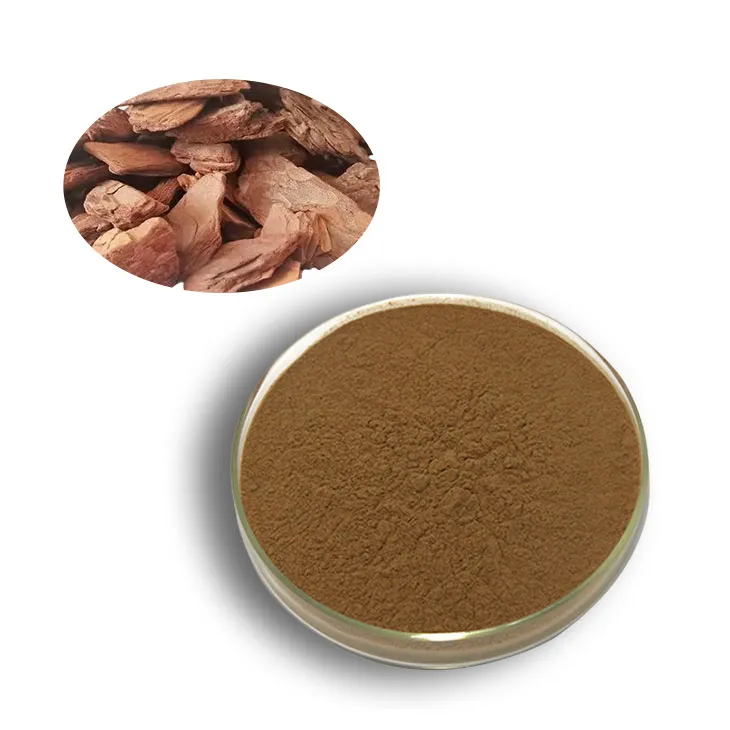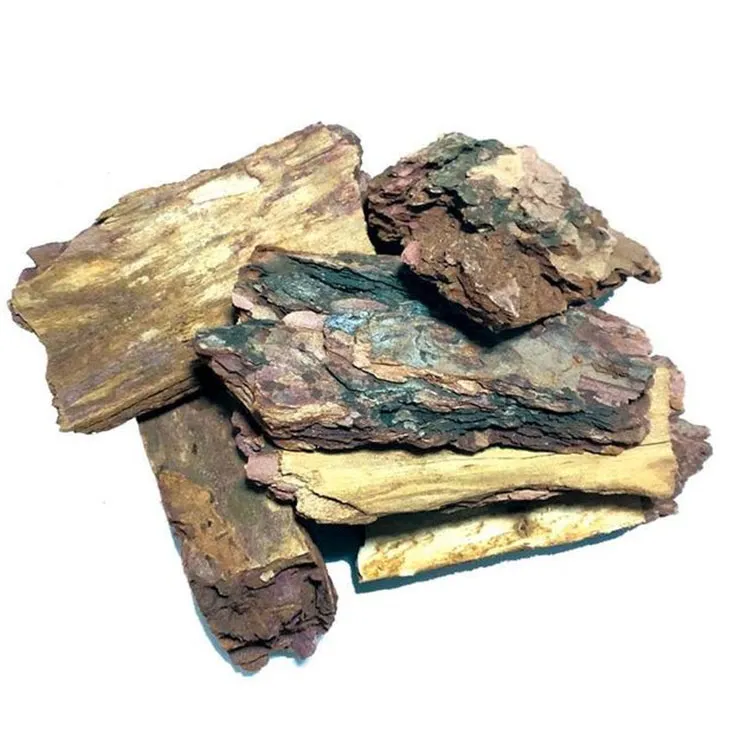- 0086-571-85302990
- sales@greenskybio.com
The process of extracting pine bark proanthocyanidins from pine bark extract powder.
2024-11-26

1. Introduction
Pine bark has long been recognized as a valuable source of bioactive compounds, with proanthocyanidins being one of the most significant. Proanthocyanidins are a class of polyphenolic compounds known for their antioxidant, anti - inflammatory, and other beneficial biological properties. Pine bark Extract Powder serves as a convenient starting material for the extraction of these important proanthocyanidins.

2. The Unique Properties of Pine Bark as a Source of Proanthocyanidins
Pine bark contains a relatively high concentration of proanthocyanidins compared to many other plant materials. The structure of pine bark proanthocyanidins is complex and diverse, consisting of multiple phenolic subunits. These subunits can vary in their degree of polymerization, which in turn affects the biological activity and solubility of the proanthocyanidins. The presence of lignin and other cell - wall components in pine bark also influences the extraction process, as they can act as barriers to the release of proanthocyanidins.

3. Extraction Procedures
3.1 Solvent Selection
The choice of extraction solvent is crucial in determining the yield and quality of pine bark proanthocyanidins. Aqueous - organic solvent mixtures are often preferred. For example, a mixture of water and ethanol has been widely used. Ethanol is a good solvent for phenolic compounds due to its ability to disrupt hydrogen bonds and solvate the phenolic hydroxyl groups. Water, on the other hand, can help in maintaining the stability of the proanthocyanidins. Different ratios of water to ethanol can be explored to optimize the extraction. For instance, a ratio of 50:50 (v/v) may be suitable in some cases, while in others, a higher or lower ratio may be more effective.
Another solvent option is methanol - water mixtures. Methanol can also effectively extract proanthocyanidins, but it has some toxicity concerns. Therefore, appropriate safety measures need to be taken when using methanol - based solvents. Acetone - water mixtures are also considered, as acetone can dissolve a wide range of phenolic compounds. However, the use of acetone may require more careful handling due to its volatility.
3.2 Enzymatic Pretreatment
Enzymatic pretreatment prior to extraction can significantly improve the extraction efficiency of pine bark proanthocyanidins. Enzymes such as cellulases and hemicellulases can break down the cell - wall components of pine bark, making the proanthocyanidins more accessible for extraction. For example, cellulase can hydrolyze cellulose, which is a major component of the cell wall. This hydrolysis creates pores and channels in the cell wall, allowing the extraction solvent to reach the proanthocyanidins more easily.
The process of enzymatic pretreatment involves adjusting the pH and temperature to the optimal conditions for the enzyme activity. The enzyme concentration also needs to be carefully controlled. Too low a concentration may not result in sufficient cell - wall degradation, while too high a concentration can be costly and may lead to unwanted side reactions.
3.3 Extraction Conditions
In addition to solvent selection and enzymatic pretreatment, other extraction conditions play important roles. Temperature is one such factor. Generally, higher temperatures can increase the solubility of proanthocyanidins and the rate of extraction. However, excessive temperatures may cause degradation of the proanthocyanidins. A temperature range of 40 - 60°C is often considered suitable for extraction.
Extraction time also affects the yield. Longer extraction times may lead to higher yields up to a certain point, but after that, further extraction may not be beneficial and may even result in the extraction of unwanted impurities. Typically, extraction times can range from a few hours to several days, depending on the nature of the Pine bark Extract Powder and the extraction conditions.
Agitation during extraction can enhance the mass transfer between the solid Pine bark Extract Powder and the extraction solvent. Gentle agitation, such as magnetic stirring or shaking, can ensure that the solvent is in good contact with all parts of the powder, facilitating the extraction process.

4. Analysis of the Chemical Structure and Biological Activity of Extracted Proanthocyanidins
4.1 Chemical Structure Analysis
Understanding the chemical structure of the extracted pine bark proanthocyanidins is essential. Spectroscopic techniques such as UV - Vis spectroscopy can provide information about the presence of phenolic groups. Infrared spectroscopy (IR) can be used to identify the functional groups in the proanthocyanidins, such as hydroxyl and carbonyl groups. Nuclear magnetic resonance (NMR) spectroscopy is a powerful tool for determining the detailed structure of the proanthocyanidins, including the connectivity of the phenolic subunits.
Mass spectrometry (MS) can also be employed to analyze the molecular weight and fragmentation patterns of the proanthocyanidins. By combining these spectroscopic and mass spectrometric techniques, a comprehensive understanding of the chemical structure of the extracted proanthocyanidins can be achieved.
4.2 Biological Activity Analysis
The biological activity of pine bark proanthocyanidins is of great interest. Antioxidant activity is one of the most studied properties. In vitro assays such as the DPPH (2, 2 - diphenyl - 1 - picrylhydrazyl) radical scavenging assay and the ABTS (2, 2' - azinobis - (3 - ethylbenzothiazoline - 6 - sulfonic acid)) radical cation scavenging assay can be used to evaluate the antioxidant capacity of the extracted proanthocyanidins.
Anti - inflammatory activity can be investigated using cell - based assays. For example, the effect of pine bark proanthocyanidins on the production of inflammatory cytokines such as interleukin - 6 (IL - 6) and tumor necrosis factor - alpha (TNF - α) in macrophages can be studied. In vivo studies in animal models can also provide valuable information about the anti - inflammatory potential of the proanthocyanidins.
Other biological activities such as anti - cancer activity, cardioprotective activity, and neuroprotective activity are also being explored. For anti - cancer activity, studies may focus on the ability of pine bark proanthocyanidins to inhibit the growth and proliferation of cancer cells. In the case of cardioprotective activity, their effect on blood lipid levels, blood pressure, and endothelial function may be investigated. For neuroprotective activity, their impact on neuronal survival and function in models of neurodegenerative diseases may be studied.
5. Conclusion
The extraction of pine bark proanthocyanidins from pine bark extract powder is a complex process that involves multiple factors. The selection of appropriate extraction solvents, the use of enzymatic pretreatment, and the optimization of extraction conditions all contribute to the yield and quality of the extracted proanthocyanidins. Additionally, the analysis of their chemical structure and biological activity is crucial for understanding their potential applications in various fields such as medicine, food, and cosmetics. Further research is still needed to fully explore the potential of pine bark proanthocyanidins and to develop more efficient and sustainable extraction methods.
FAQ:
What are the unique properties of pine bark that make it a rich source of proanthocyanidins?
Pine bark contains a relatively high amount of phenolic compounds, including proanthocyanidins. Its cell structure and chemical composition are such that these compounds are stored within. The presence of lignin and cellulose in pine bark also plays a role in protecting and retaining these valuable proanthocyanidins. Additionally, pine bark has a certain degree of porosity which can allow solvents to penetrate during extraction, facilitating the release of proanthocyanidins.
How do different extraction solvents affect the yield and quality of pine bark proanthocyanidins?
Different solvents have different polarities and solubilities. For example, aqueous - organic solvent mixtures can have a significant impact. Organic solvents like ethanol can dissolve non - polar components of the pine bark extract powder well, while water can help in dissolving polar substances. A proper ratio of aqueous - organic solvent can enhance the solubility of proanthocyanidins, thus increasing the yield. However, if the solvent is too polar or non - polar, it may also extract unwanted substances along with proanthocyanidins, affecting the quality. For instance, a highly polar solvent might extract more sugars and other impurities, while a very non - polar solvent may not be able to fully extract the proanthocyanidins.
Why is enzymatic pretreatment considered before extraction?
Enzymatic pretreatment can break down the cell wall structure of pine bark. The cell wall of pine bark is composed of complex substances like lignin, cellulose and hemicellulose. Enzymes can specifically target and degrade these components, making it easier for the extraction solvents to access the proanthocyanidins stored inside the cells. This results in an improvement in extraction efficiency as more proanthocyanidins can be released from the cells that were previously difficult to access due to the intact cell wall.
What is the significance of analyzing the chemical structure of extracted pine bark proanthocyanidins?
Analyzing the chemical structure helps in understanding the properties and reactivity of proanthocyanidins. It can provide insights into how they interact with other substances, both in vitro and in vivo. The chemical structure also determines their antioxidant activity, potential for bio - availability, and their ability to form complexes with other molecules. This knowledge is crucial for predicting their biological activity and potential applications in various fields such as medicine, food and cosmetics.
How can we ensure the quality of pine bark proanthocyanidins during the extraction process?
To ensure quality, first, the selection of high - quality pine bark extract powder is essential. Then, during extraction, the proper choice of extraction solvents and conditions, such as temperature, pH and extraction time, needs to be carefully controlled. Avoiding over - extraction which may lead to the extraction of impurities is important. Additionally, purification steps after extraction, such as filtration and chromatography, can be used to remove unwanted substances and improve the purity of the proanthocyanidins.
Related literature
- Extraction and Characterization of Proanthocyanidins from Pine Bark: A Review"
- "Optimization of Pine Bark Proanthocyanidin Extraction: Solvent Selection and Process Parameters"
- "The Chemical Structure and Biological Activity of Pine Bark Proanthocyanidins: A Comprehensive Study"
- ▶ Hesperidin
- ▶ citrus bioflavonoids
- ▶ plant extract
- ▶ lycopene
- ▶ Diosmin
- ▶ Grape seed extract
- ▶ Sea buckthorn Juice Powder
- ▶ Beetroot powder
- ▶ Hops Extract
- ▶ Artichoke Extract
- ▶ Reishi mushroom extract
- ▶ Astaxanthin
- ▶ Green Tea Extract
- ▶ Curcumin Extract
- ▶ Horse Chestnut Extract
- ▶ Other Problems
- ▶ Boswellia Serrata Extract
- ▶ Resveratrol Extract
- ▶ Marigold Extract
- ▶ Grape Leaf Extract
- ▶ blog3
- ▶ blog4
-
100% Pure Natural Goldenseal Extract.
2024-11-26
-
Standard - process hop extract.
2024-11-26
-
How to make powder with moringa powder.
2024-11-26
-
Standard - process rosemary extract.
2024-11-26
-
Astaxanthin
2024-11-26
-
Oyster Mushroom Extract Powder
2024-11-26
-
Thunder God Vine Extract
2024-11-26
-
Curcuma Longa Extract
2024-11-26
-
Buckthorn bark extract
2024-11-26
-
Sugarcane Extract
2024-11-26
-
Moringa powder
2024-11-26
-
Dandelion Root Extract
2024-11-26
-
Honeysuckle Pollen
2024-11-26
-
Nutmeg Extract
2024-11-26





















